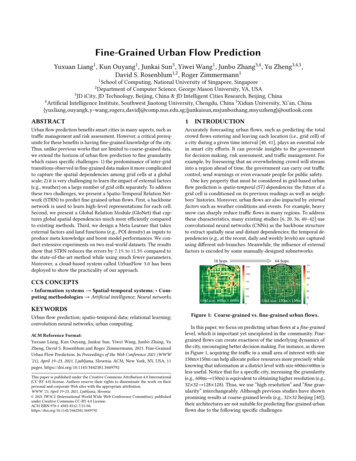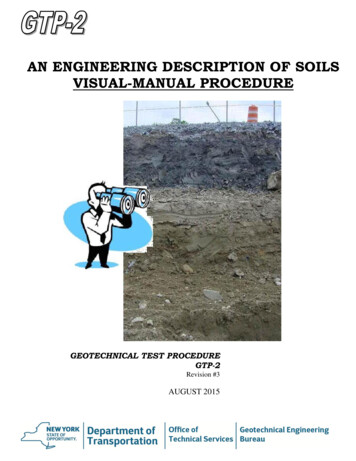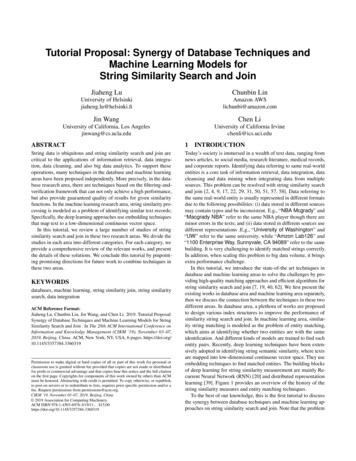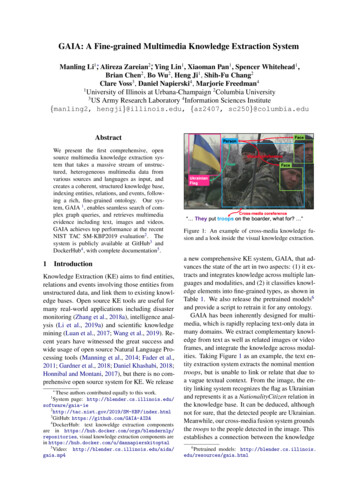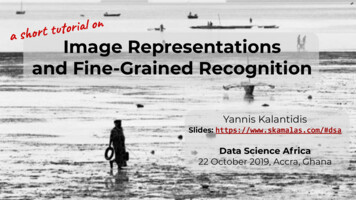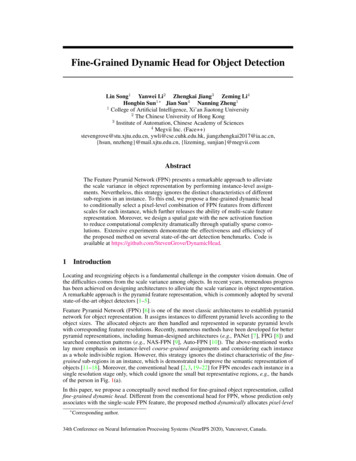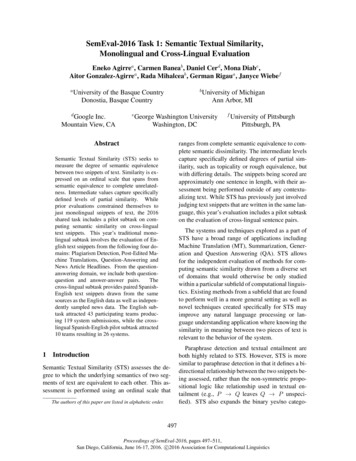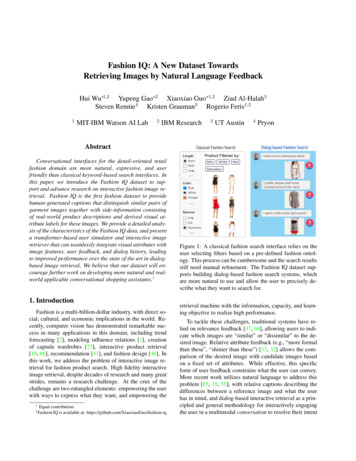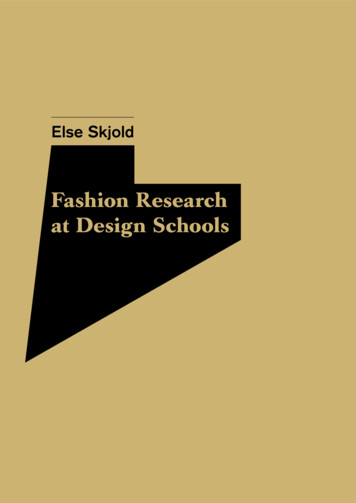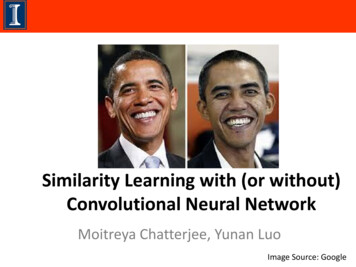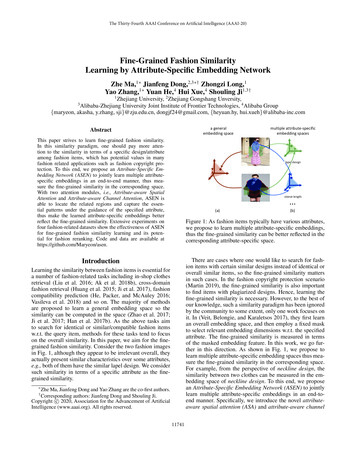
Transcription
The Thirty-Fourth AAAI Conference on Artificial Intelligence (AAAI-20)Fine-Grained Fashion SimilarityLearning by Attribute-Specific Embedding NetworkZhe Ma,1 Jianfeng Dong,2,3 † Zhongzi Long,1Yao Zhang,1 Yuan He,4 Hui Xue,4 Shouling Ji1,3†1Zhejiang University, 2 Zhejiang Gongshang Unversity,Alibaba-Zhejiang University Joint Institute of Frontier Technologies, 4 Alibaba Group{maryeon, akasha, y.zhang, sji}@zju.edu.cn, dongjf24@gmail.com, {heyuan.hy, hui.xueh}@alibaba-inc.com3a generalembedding spaceAbstractThis paper strives to learn fine-grained fashion similarity.In this similarity paradigm, one should pay more attention to the similarity in terms of a specific design/attributeamong fashion items, which has potential values in manyfashion related applications such as fashion copyright protection. To this end, we propose an Attribute-Specific Embedding Network (ASEN) to jointly learn multiple attributespecific embeddings in an end-to-end manner, thus measure the fine-grained similarity in the corresponding space.With two attention modules, i.e., Attribute-aware SpatialAttention and Attribute-aware Channel Attention, ASEN isable to locate the related regions and capture the essential patterns under the guidance of the specified attribute,thus make the learned attribute-specific embeddings betterreflect the fine-grained similarity. Extensive experiments onfour fashion-related datasets show the effectiveness of ASENfor fine-grained fashion similarity learning and its potential for fashion reranking. Code and data are available athttps://github.com/Maryeon/asen.multiple attribute-specificembedding spaceslapel designsleeve length.(a)(b)Figure 1: As fashion items typically have various attributes,we propose to learn multiple attribute-specific embeddings,thus the fine-grained similarity can be better reflected in thecorresponding attribute-specific space.There are cases where one would like to search for fashion items with certain similar designs instead of identical oroverall similar items, so the fine-grained similarity mattersin such cases. In the fashion copyright protection scenario(Martin 2019), the fine-grained similarity is also importantto find items with plagiarized designs. Hence, learning thefine-grained similarity is necessary. However, to the best ofour knowledge, such a similarity paradigm has been ignoredby the community to some extent, only one work focuses onit. In (Veit, Belongie, and Karaletsos 2017), they first learnan overall embedding space, and then employ a fixed maskto select relevant embedding dimensions w.r.t. the specifiedattribute. The fine-grained similarity is measured in termsof the masked embedding feature. In this work, we go further in this direction. As shown in Fig. 1, we propose tolearn multiple attribute-specific embedding spaces thus measure the fine-grained similarity in the corresponding space.For example, from the perspective of neckline design, thesimilarity between two clothes can be measured in the embedding space of neckline design. To this end, we proposean Attribute-Specific Embedding Network (ASEN) to jointlylearn multiple attribute-specific embeddings in an end-toend manner. Specifically, we introduce the novel attributeaware spatial attention (ASA) and attribute-aware channelIntroductionLearning the similarity between fashion items is essential fora number of fashion-related tasks including in-shop clothesretrieval (Liu et al. 2016; Ak et al. 2018b), cross-domainfashion retrieval (Huang et al. 2015; Ji et al. 2017), fashioncompatibility prediction (He, Packer, and McAuley 2016;Vasileva et al. 2018) and so on. The majority of methodsare proposed to learn a general embedding space so thesimilarity can be computed in the space (Zhao et al. 2017;Ji et al. 2017; Han et al. 2017b). As the above tasks aimto search for identical or similar/compatible fashion itemsw.r.t. the query item, methods for these tasks tend to focuson the overall similarity. In this paper, we aim for the finegrained fashion similarity. Consider the two fashion imagesin Fig. 1, although they appear to be irrelevant overall, theyactually present similar characteristics over some attributes,e.g., both of them have the similar lapel design. We considersuch similarity in terms of a specific attribute as the finegrained similarity. Zhe Ma, Jianfeng Dong and Yao Zhang are the co-first authors.Corresponding authors: Jianfeng Dong and Shouling Ji.c 2020, Association for the Advancement of ArtificialCopyright Intelligence (www.aaai.org). All rights reserved.†11741
complex backgrounds, pose variations, etc., attention mechanism is also common in the fashion domain (Ji et al. 2017;Wang et al. 2017b; Han et al. 2017a; Ak et al. 2018a;2018b). For instance, (Ak et al. 2018b) use the prior knowledge of clothes structure to locate the specific parts ofclothes. However, their approach can be only used for upperbody clothes thus limits its generalization. (Wang et al.2017b) propose to learn a channel attention implementedby a fully convolutional network. The above attentions arein a self-attention manner without explicit guidance for attention mechanism. In this paper, we propose two attributeaware attention modules, which utilize a specific attribute asthe extra input in addition to a given image. The proposedattention modules capture the attribute-related patterns under the guidance of the specified attribute. Note that (Ji etal. 2017) also utilize attributes to facilitate attention modeling, but they use all attributes of fashion items and aimfor learning a better discriminative fashion feature. By contrast, we employ each attribute individually to obtain morefine-grained attribute-aware feature for fine-grained similarity computation.attention (ACA) modules in the network, allowing the network being able to locate the related regions and capturethe essential patterns w.r.t. the specified attribute. It is worthpointing out that fine-grained similarity learning is orthogonal to overall similarity learning, allowing us to utilizeASEN to facilitate traditional fashion retrieval, such as inshop clothes retrieval. In sum, this paper makes the following contributions: Conceptually, we propose to learn multiple attributespecific embedding spaces for fine-grained fashion similarity prediction. As such, a certain fine-grained similaritybetween fashion items can be measured in the corresponding space. We propose a novel ASEN model to effectively realize theabove proposal. Combined with ACA and ASA, the network extracts essential features under the guidance of thespecified attribute, which benefits the fine-grained similarity computation. Experiments on FashionAI, DARN, DeepFashion andZappos50k datasets demonstrate the effectiveness of proposed ASEN for fine-grained fashion similarity learningand its potential for fashion reranking.Proposed MethodNetwork StructureRelated WorkGiven an image I and a specific attribute a, we proposeto learn an attribute-specific feature vector f (I, a) Rcwhich reflects the characteristics of the corresponding attribute in the image. Therefore, for two fashion imagesI and I , the fine-grained fashion similarity w.r.t. the attribute a can be expressed by the cosine similarity betweenf (I, a) and f (I , a). Moreover, the fine-grained similarityfor multiple attributes can be computed by summing up thesimilarity scores on the individual attributes. Note that theattribute-specific feature vector resides in the correspondingattribute-specific embedding space. If there are n attributes,n attribute-specific embedding spaces can be learned jointly.Fig. 2 illustrates the structure of our proposed network.The network is composed of a feature extraction branchcombined with an attribute-aware spatial attention and anattribute-aware channel attention. For the ease of reference,we name the two attention modules as ASA and ACA, respectively. In what follows, we first detail the input representation, followed by the description of two attribute-awareattention modules.Fashion Similarity Learning To compute the similarity between fashion items, the majority of existing works (Liuet al. 2016; Gajic and Baldrich 2018; Shankar et al. 2017;Ji et al. 2017; Huang et al. 2015) learn a general embedding space thus the similarity can be measured in the learnedspace by standard distance metric, e.g., cosine distance. Forinstance, in the context of in-shop clothes retrieval, (Liu etal. 2016) employs a Convolutional Neural Network (CNN)to embed clothes into a single compact feature space. Similarly, for the purpose of fashion compatibility prediction,(Veit et al. 2015) also utilize a CNN to map fashion itemsin an embedding space, thus predict whether two input fashion items are compatible in the space. Different from theabove methods that focus on the overall similarity (identical or overall similar/compatible), we study the fine-grainedsimilarity in the paper. (Veit, Belongie, and Karaletsos 2017)have made a first attempt in this direction. In their approach,an overall embedding space is first learned, and the finegrained similarity is measured in this space with the fixedmask w.r.t. a specified attribute. By contrast, we jointly learnmultiple attribute-specific embedding spaces, and measurethe fine-grained similarity in the corresponding attributespecific space. It is worth noting that (Vasileva et al. 2018;He, Packer, and McAuley 2016) also learn multiple embedding spaces, but they still focus on the overall similarity.Attention Mechanism Recently attention mechanism hasbecome a popular technique and showed superior effectiveness in various research areas, such as computer vision(Woo et al. 2018; Wang et al. 2017a; Qiao, Dong, and Xu2018) and natural language processing (Vaswani et al. 2017;Bahdanau, Cho, and Bengio 2014). To some extent, attention can be regarded as a tool to bias the allocation of theinput information. As fashion images always present withInput Representation To represent the image, we employa CNN model pre-trained on ImageNet (Deng et al. 2009) asa backbone network, e.g., ResNet (He et al. 2016). To keepthe spatial information of the image, we remove the last fullyconnected layers in the CNN. So the image is representedby I Rc h w , where h w is the size of the featuremap, c indicates the number of channels. For the attribute,we represent it with a one-hot vector a {0, 1}n , wheren N indicates the number of different attributes.Attribute-aware Spatial Attention (ASA) Consideringthe attribute-specific feature is typically related to the specific regions of the image, we only need to focus on thecertain related regions. For instance, in order to extract the11742
Sum ge I.f(I,a)Feature Extractionp(I)1x1 convp(a)sFCαsαcq(a)Attribute-aware Spatial AttentionEmbeddingnecklinedesignSoftmax1x1 convDuplicatenecklinedesignEmbeddingattribute aConcatenateattribute aFCAttribute-aware Channel AttentionFigure 2: The structure of our proposed Attribute-Specific Embedding Network (ASEN). Mathematical notations by the side offunction blocks (e.g., αc on the right of FC layer) denotes their output.the attention weights. With adaptive attention weights, thespatially attended feature vector of the image I w.r.t. a specific attribute a is calculated as:h w Is αsj Ij .(4)attribute-specific feature of the neckline design attribute, theregion around neck is much more important than the others.Besides, as fashion images always show up in large variations, e.g., various poses and scales, using a fixed regionwith respect to a specific attribute for all images is not optimal. Hence, we propose an attribute-aware spatial attention which adaptively attends to certain regions of the inputimage under the guidance of a specific attribute. Given animage I and a specific attribute a, we obtain the spatially attended vector w.r.t. the given attribute a by Is Atts (I, a),where the attended vector is computed as the weighted average of input image feature vectors according to the givenattribute. Specifically, we first transform the image and theattribute to make their dimensionality same. For the image, we employ a convolutional layer followed by a nonlinear tanh activation function. Formally, the mapped image p(I) Rc h w is given byp(I) tanh(Convc (I)),(1) where Convc indicates a convolutional layer that containsc 1 1 convolution kernels. For the attribute, we first projectit into a c -dimensional vector through an attribute embedding, implemented by a Fully Connected (FC) layer, thenperform spatial duplication. Hence, the mapped attribute p(a) Rc h w isp(a) tanh(Wa a) · 1,(2)jcwhere αsj R and Ij R are the attention weight and thefeature vector at location j of αs and I, respectively.Attribute-aware Channel Attention (ACA) Althoughthe attribute-aware spatial attention adaptively focuses onthe specific regions in the image, the same regions may stillbe related to multiple attributes. For example, attributes collar design and collar color are all associated with the regionaround collar. Hence, we further employ attribute-awarechannel attention over the spatially attended feature vectorIs . The attribute-aware channel attention is designed as anelement-wise gating function which selects the relevant dimensions of the spatially attended feature with respect to thegiven attribute. Concretely, we first employ an attribute embedding layer to embed attribute a into an embedding vectorwith the same dimensionality of Is , that is:q(a) δ(Wc a)(5)c ndenotes the embedding parameters andwhere Wc Rδ refers to ReLU function. Note we use separated attributeembedding layers in ASA and ACA, considering the different purposes of the two attentions. Then the attribute and thespatially attended feature are fused by simple concatenation,and further fed into the subsequent two FC layers to obtainthe attribute-aware channel attention weights. As suggestedin (Hu, Shen, and Sun 2018), we implement the two FC layers by a dimensionality-reduction layer with reduction rate rand a dimensionality-increasing layer, which have fewer parameters than one FC layer. Formally, the attention weightsαc Rc is calculated by: Where Wa Rc n denotes the transformation matrix and1 R1 h w indicates spatially duplicate matrix. After thefeature mapping, the attention weights αs Rh w is computed ass tanh(Conv1 (p(a) p(I))),αs sof tmax(s),(3)where indicates the element-wise multiplication, Conv1is a convolutional layer only containing one 1 1 convolution kernel. Here, we employ a sof tmax layer to normalizeαc σ(W2 δ(W1 [q(a), Is ])),11743(6)
where [, ] denotes concatenationoperation, σcindicates sigcmoid function, W1 R r 2c and W2 Rc r are transformation matrices. Here we omit the bias terms for descriptionsimplicity. The final output of the ACA is obtained by scaling Is with the attention weight αc :Ic Is α c .Datasets As there are no existing datasets for attributespecific fashion retrieval, we reconstruct three fashiondatasets with attribute annotations to fit the task, i.e., FashionAI (Zou et al. 2019), DARN (Huang et al. 2015) andDeepFashion(Liu et al. 2016). For triplet relation prediction,we utilize Zappos50k (Yu and Grauman 2014). FashionAI isa large scale fashion dataset with hierarchical attribute annotations for fashion understanding. We choose to use theFashionAI dataset, because of its high-quality attribute annotations. As the full FashionAI has not been publicly released, we utilize its early version released for the FashionAIGlobal Challenge 20181 . The released FashionAI datasetconsists of 180,335 apparel images, where each image is annotated with a fine-grained attribute. There are 8 attributes,and each attribute is associated with a list of attribute values. Take the attribute neckline design for instance, thereare 11 corresponding attribute values, such as round neckline and v neckline. We randomly split images into three setsby 8:1:1, which is 144k / 18k / 18k images for training / validation / test. Besides, for every epoch, we construct 100ktriplets from the training set for model training. Concretely,for a triplet with respect to a specific attribute, we randomlysample two images of the same corresponding attribute values as the relevant pair and an image with different attributevalue as the irrelevant one. For validation or test set, 3600images are randomly picked out as the query images, withremaining images annotated with the same attribute as thecandidate images for retrieval. Additionally, we reconstructDARN and DeepFashion in the same way as FashionAI. Details are included in the supplementary material.Zappos50k is a large shoe dataset consisting of 50,025images collected from the online shoe and clothing retailerZappos.com. For the ease of cross-paper comparison, we utilize the identical split provided by (Veit, Belongie, and Karaletsos 2017). Specifically, we use 70% / 10% / 20% imagesfor training / validation / test. Each image is associated withfour attributes: the type of the shoes, the suggested genderof the shoes, the height of the shoes’ heels and the closingmechanism of the shoes. For each attribute, 200k training,20k validation and 40k testing triplets are sampled for modeltraining and evaluation.(7)Finally, we further employ a FC layer over Ic to generatethe attribute-specific feature of the given image I with thespecified attribute a:f (I, a) W Ic b,c c(8)cis the transformation matrix, b R indiwhere W Rcates the bias term.Model LearningWe would like to achieve multiple attribute-specific embedding spaces where the distance in a particular space is smallfor images with the same specific attribute value, but largefor those with the different ones. Consider the neckline design attribute for instance, we expect the fashion imageswith Round Neck near those with the same Round Neck inthe neckline design embedding space, but far away fromthose with V Neck. To this end, we choose to use the tripletranking loss which is consistently found to be effective inmultiple embedding learning tasks (Vasileva et al. 2018;Dong et al. 2019). Concretely, we first construct a set oftriplets T {(I, I , I a)}, where I and I indicate images relevant and irrelevant with respect to image I in termsof attribute a. Given a triplet of {(I, I , I a)}, triplet ranking loss is defined asL(I, I , I a) max{0, m s(I, I a) s(I, I a)},(9)where m represents the margin, empirically set to be 0.2,s(I, I a) denotes the fine-grained similarity w.r.t. the attribute a which can be expressed by the cosine similaritybetween f (I, a) and f (I , a). Finally, we train the model tominimize the triplet ranking loss on the triplet set T , and theoverall objective function of the model is as: L(I, I , I a),(10)argminθMetrics For the task of attribute-specific fashion retrieval,we report the Mean Average Precision (MAP), a popularperformance metric in many retrieval-related tasks (Awad etal. 2018; Dong, Li, and Xu 2018). For the triplet relation prediction task, we utilize the prediction accuracy as the metric.Due to the limited space of the paper, we present resultson DeepFashion, implementation details and efficiency evaluation of our proposed model in the supplementary material.(I,I ,I a) Twhere θ denotes all trainable parameters of our proposednetwork.EvaluationExperimental SetupTo verify the viability of the proposed attribute-specific embedding network for fine-grained fashion similarity computation, we evaluate it on the following two tasks. (1)Attribute-specific fashion retrieval: Given a fashion imageand a specified attribute, its goal is to search for fashion images of the same attribute value with the given image. (2)Triplet relation prediction: Given a triplet of {I, I , I } anda specified attribute, the task is asked to predict whether therelevance between I and I is larger than that between I andI in terms of the given attribute.Attribute-Specific Fashion RetrievalTable 1 summarizes the performance of different modelson FashionAI, and performance of each attribute type arealso reported. As a sanity check, we also give the performance of a random baseline which sorts candidate images randomly. All the learning methods are noticeably better than the random result. Among the five learning chi/FashionAI
Table 1: Performance of attribute-specific fashion retrieval on FashionAI. Our proposed ASEN model consistently outperformsthe other counterparts for all attribute types.MAP for each attributeMethodRandom baselineTriplet networkCSNASEN w/o ASAASEN w/o ACAASENMAPskirt lengthsleeve lengthcoat lengthpant lengthcollar designlapel designneckline designneck 938.5253.5256.3550.8761.02Table 2: Performance of attribute-specific fashion retrieval on DARN. AESN with both ACA and ASA again performs best.MAP for each attributeMethodRandom baselineTriplet networkCSNASEN w/o ASAASEN w/o ACAASENQuery imageMAPclothes categoryclothes buttonclothes colorclothes lengthclothes patternclothes shapecollar shapesleeve lengthsleeve .3948.0253.31Top-8 images retrieved from test set of FashionAI datasetnecklinedesignsleevelengthFigure 3: Attribute-specific fashion retrieval examples on FashionAI. Green bounding box indicates the image has the sameattribute value with the given image in terms of the given attribute, while the red one indicates the different attribute values.The results demonstrate that our ASEN is good at capturing the fine-grained similarity among fashion items.the DARN dataset. Similarly, our proposed ASEN outperforms the other counterparts. The result again confirms theeffectiveness of the proposed model for fine-grained fashionsimilarity computation. Additionally, we also try the verification loss (Zheng, Zheng, and Yang 2017) in ASEN, butfind its performance (MAP 50.63) worse than the tripletloss counterpart (MAP 61.02) on FashionAI. Some qualitative results of ASEN are shown in Fig. 3. Note that theretrieved images appear to be irrelevant to the query image,as ASEN focuses on the fine-grained similarity instead ofthe overall similarity. It can be observed that the majority ofretrieved images share the same specified attribute with thequery image. Consider the second example for instance, although the retrieved images are in various fashion category,such as dress and vest, all of them are sleeveless. These results allow us to conclude that our model is able to figure outfine-grained patterns in images.models, the triplet network which learns a general embedding space performs the worst in terms of the overall performance, scoring the overall MAP of 38.52%. The resultshows that a general embedding space is suboptimal forfine-grained similarity computation. Besides, our proposedASEN outperforms CSN (Veit, Belongie, and Karaletsos2017) with a clear margin. We attribute the better performance to the fact that ASEN adaptively extracts featurew.r.t. the given attribute by two attention modules, whileCSN uses a fixed mask to select relevant embedding dimensions. Moreover, we investigate ASEN with a single attention, resulting in two reduced models, i.e., ASEN w/oASA and ASEN w/o ACA. These two variants obtain theoverall MAP of 56.35 and 50.87, respectively. The lowerscores justify the necessity of both ASA and ACA attentions. The result also suggests that attribute-aware channelattention is more beneficial. Table 2 shows the results on11745
Table 3: Performance of triplet relation prediction on Zappos50k. Our proposed ASEN is the best.MethodPrediction Accuracy(%)Random baselineTriplet networkCSNASEN w/o ASAASEN w/o ACAASEN50.0076.2889.2790.1889.0190.79(a) coat(b) pant(c) sleeve(d) skirt(e) lapel(f) neck(g) neckline(h) collarFigure 5: t-SNE visualization of attribute-specific embedding spaces obtained by our proposed ASEN on FashionAIdataset. Dots with the same color indicate images annotatedwith the same attribute value. Best viewed in zoom in.(a) on FashionAI(b) on DARN(c) on Zappos50kFigure 4: Images from FashionAI, DARN and Zappos50k,showing the images of Zappos50k are less challenging.Figure 6: t-SNE visualization of a whole embedding spacecomprised of eight attribute-specific embedding spaceslearned by ASEN. Dots with the same color indicate imagesin the same attribute-specific embedding space.Triplet Relation PredictionTable 3 shows the results on the Zappos50k dataset. Unsurprisingly, the random baseline achieves the worst performance as it predicts by random guess. Among the fourembedding learning models, our proposed model variantsagain outperform triplet network which only learns a general embedding space with a large margin. The result verifiesthe effectiveness of learning attribute-specific embeddingsfor triplet relation prediction. Although ASEN is still betterthan its counterparts ASEN without ASA or ACA, its performance improvement is much less than that on FashionAIand DARN. We attribute it to that images in Zappos50k aremore iconic and thus easier to understand (see Fig. 4), soonly ASA or ACA is enough to capture the fine-grained similarity for such “easy” images.space. In other words, images with the same attribute valueare close while images with different attribute value arefar away. The result shows the good discriminatory ability of the learned attribute-specific embeddings by ASEN.One may ask what is the relationship between the attributespecific embedding spaces? To answer this question, we visualize eight attribute-specific embeddings into a whole 2dimensional space. As shown in Fig. 6, different attributespecific embeddings learned by ASEN are well separated.The result is consistent with the fact that different attributesreflect different characteristics of fashion items.Attention Visualization To gain further insight of ourproposed network, we visualize the learned attribute-awarespatial attention. As shown in Fig. 7, the learned attentionmap gives relative high responses on the relevant regionswhile low responses on irrelevant regions with the specifiedattribute, showing the attention is able to figure out whichregions are more important for a specific attribute. An interesting phenomenon can be observed that attention mapsfor length-related attributes are more complicated than thatfor design-related attributes; multiple regions show high response for the former. We attribute it to that the model requires to locate the start and end of a fashion item thus spec-What has ASEN Learned?t-SNE Visualization In order to investigate what has theproposed ASEN learned, we first visualize the obtainedattribute-specific embedding spaces. Specifically, we take alltest images from FashionAI, and use t-SNE (Maaten andHinton 2008) to visualize their distribution in 2-dimensionalspaces. Fig. 5 presents eight attribute-specific embeddingspaces w.r.t. coat, pant, sleeve, skirt length and lapel, neck,neckline, collar design respectively. It is clear that dotswith different colors are well separated and dots with thesame color are more clustered in the particular embedding11746
coat lengthneck designskirt lengthneck designlapel designneck designsleeve lengthneck designcoat lengthsleeve lengthskirt lengthneck designFigure 7: Visualization of the attribute-aware spatial attention with the guidance of a specified attribute (above the attentionimage) on FashionAI.Query imageTop-10 images retrieved from test set of DeepFashion datasetre-rank with sleeve lengthre-rank with lapel designFigure 8: Reranking examples for in-shop clothes retrieval on DeepFashion dataset. The ground-truth images are marked withgreen bounding box. After reranking by our proposed ASEN, the retrieval results become better.sleeve are ranked later. Obviously, after reranking, the retrieval results become better. The result shows the potentialof our proposed ASEN for fashion reranking.ulate its length. Besides, consider the last example with respect to neck design attribute, when the specified attributeneck design can not be reflected in the image the attentionresponse is almost uniform, which further demonstrates theeffectiveness of attribute-aware spatial attention.Summary and ConclusionsThe Potential for Fashion RerankingIn this experiment, we explore the potential of ASEN forfashion reranking. Specifically, we consider in-shop clothesretrieval task, in which given a query of in-shop clothes, thetask is asked to retrieve the same items. Triplet network isused as the baseline to obtain the initial retrieval result. Theinitial top 10 images are reranked in descending order bythe fine-grained fashion similarity obtained by ASEN. Wetrain the triplet network on the official training set of DeepFashion, and directly use ASEN previously trained on FashionAI for the attribute-specific fashion retrieval task. Fig. 8presents two reranking examples. For the first example, byreranking in terms of the fine-grained similarity of sleevelength, images have the same short sleeve with the queryimage are ranked higher, while the others with mid or longThis paper targets at the fine-grained similarity in the fashion scenario. We contribute an Attribute-Specific EmbeddingNetwork (ASEN) with two attention modules, i.e., ASA andACA. ASEN jointly learns multiple attribute-specific embeddings, thus measuring the fine-grained similarity in thecorresponding space. ASEN is conceptually simple, practically effective and end-to-end. Extensive experiments onvarious datasets support the following conclusions.
fine-grained attribute-aware feature for fine-grained similar-ity computation. Proposed Method Network Structure Given an image I and a specific attribute a, we propose to learn an attribute-specific feature vector f(I,a) Rc which reflects the characteristics of the corresponding at-tribute in the image. Therefore, for two fashion images
